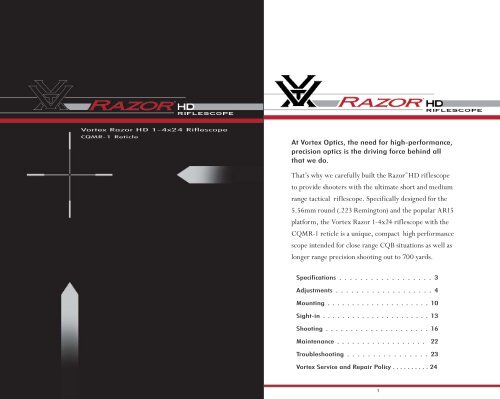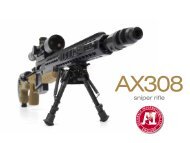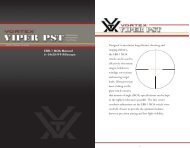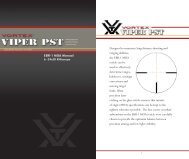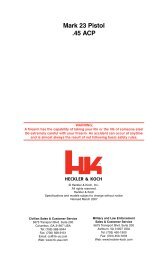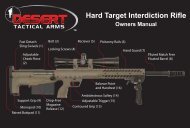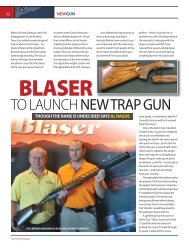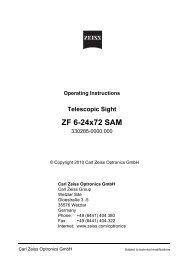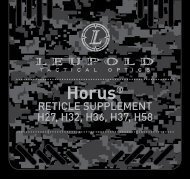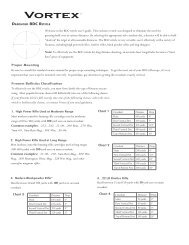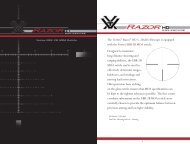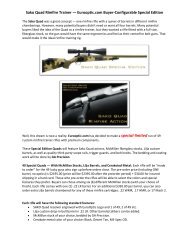Vortex Razor HD 1-4x24 rifle scope. - EuroOptic.com
Vortex Razor HD 1-4x24 rifle scope. - EuroOptic.com
Vortex Razor HD 1-4x24 rifle scope. - EuroOptic.com
You also want an ePaper? Increase the reach of your titles
YUMPU automatically turns print PDFs into web optimized ePapers that Google loves.
<strong>Vortex</strong> <strong>Razor</strong> <strong>HD</strong> 1-<strong>4x24</strong> Rifle<strong>scope</strong><br />
CQMR-1 Reticle<br />
At <strong>Vortex</strong> Optics, the need for high-performance,<br />
precision optics is the driving force behind all<br />
that we do.<br />
TM<br />
That’s why we carefully built the <strong>Razor</strong> <strong>HD</strong> <strong>rifle</strong><strong>scope</strong><br />
to provide shooters with the ultimate short and medium<br />
range tactical <strong>rifle</strong><strong>scope</strong>. Specifically designed for the<br />
5.56mm round (.223 Remington) and the popular AR15<br />
platform, the <strong>Vortex</strong> <strong>Razor</strong> 1-<strong>4x24</strong> <strong>rifle</strong><strong>scope</strong> with the<br />
CQMR-1 reticle is a unique, <strong>com</strong>pact high performance<br />
<strong>scope</strong> intended for close range CQB situations as well as<br />
longer range precision shooting out to 700 yards.<br />
Specifications . . . . . . . . . . . . . . . . . . 3<br />
Adjustments . . . . . . . . . . . . . . . . . . . 4<br />
Mounting . . . . . . . . . . . . . . . . . . . . . 10<br />
Sight-in . . . . . . . . . . . . . . . . . . . . . . 13<br />
Shooting . . . . . . . . . . . . . . . . . . . . . 16<br />
Maintenance . . . . . . . . . . . . . . . . . . 22<br />
Troubleshooting . . . . . . . . . . . . . . . . 23<br />
<strong>Vortex</strong> Service and Repair Policy . . . . . . . . . . 24<br />
1
The <strong>Vortex</strong> <strong>Razor</strong> <strong>HD</strong> 1–<strong>4x24</strong> Rifle<strong>scope</strong><br />
<strong>Razor</strong> 1–<strong>4x24</strong> Rifle<strong>scope</strong> Specifications<br />
Elevation<br />
Adjustment Knob<br />
Zero Reference<br />
Line Windage<br />
Waterproof<br />
Yes<br />
Fogproof Argon gas purging<br />
Length 10.3 inches (261.2mm)<br />
Mounting Length 6.4 inches (162.6mm)<br />
Adjustment Knob<br />
Weight 20.2 ounces (628.3g)<br />
Objective Lens<br />
MagView<br />
Fast Focus<br />
Eyepiece<br />
Eye Relief<br />
3.9 inches (99.6 mm)<br />
Field of View 94.5–24.2 feet/100 yards (18–4.6°)<br />
Reticle Style CQMR-1<br />
Windage 200 MOA Total Travel<br />
Battery Cover<br />
Elevation 200 MOA Total Travel<br />
Illumination Knob<br />
Turret Adjustment<br />
24 MOA Per Rotation<br />
1/4 MOA Per Click<br />
Magnification<br />
Adjustment Ring<br />
Reticle Focus<br />
Recoil Tested Rated for 50 BMG<br />
Battery CR2032<br />
Dimensions<br />
3.0”<br />
2.0”<br />
(76.2mm)<br />
(50.8mm)<br />
(Eyepiece)<br />
Elevation Knob<br />
Radius Bar<br />
1.3”<br />
(33.0mm)<br />
1.7”<br />
(43.2mm)<br />
.5” 6.4” (162.6mm)<br />
3.6”<br />
(12.7mm)<br />
(91.4mm)<br />
(3) Turret Cap<br />
10.3” (261.2mm)<br />
Retaining Screws<br />
BDC<br />
Reference<br />
Marks<br />
Accessories included with the <strong>Razor</strong> <strong>HD</strong><br />
Flip cap lens cover with killFLASH ® ARD<br />
Cleaning cloth<br />
Dual Use: Shooting Tactical / Hunting<br />
2 3
Rifle<strong>scope</strong> Adjustments<br />
Reticle Focus Adjustment<br />
The <strong>Vortex</strong> <strong>Razor</strong> <strong>HD</strong> 1–<strong>4x24</strong> <strong>rifle</strong><strong>scope</strong>s use a fast<br />
focus eyepiece, designed to quickly<br />
and easily adjust the focus on the<br />
<strong>rifle</strong><strong>scope</strong>s reticle.<br />
To adjust the reticle focus, look<br />
through the <strong>rifle</strong><strong>scope</strong> at a blank white<br />
wall or up at the sky. Turn the eyepiece<br />
focus knob in or out until the reticle<br />
image is as crisp as possible. Try to do<br />
this quickly, as your eye will try to<br />
<strong>com</strong>pensate for an out of focus reticle.<br />
Once this adjustment is <strong>com</strong>plete, it is not necessary to<br />
re-focus every time the <strong>scope</strong> is used. However, as your<br />
eyesight may change over time you should re-check this<br />
adjustment periodically.<br />
Warning: Looking directly at the sun through a rifl e<strong>scope</strong> or any optical<br />
instrument can cause severe and permanent damage to your eyesight.<br />
Windage and Elevation Adjustments<br />
The <strong>Vortex</strong> <strong>Razor</strong> <strong>HD</strong> 1–<strong>4x24</strong> <strong>rifle</strong><strong>scope</strong> incorporates<br />
precision finger adjustable elevation and windage dials with<br />
audible clicks.<br />
Elevation<br />
Adjustment Knob<br />
To make adjustments:<br />
• Turn the adjustment dial in<br />
the appropriate direction Up/<br />
Down or Left/Right indicated<br />
by the arrows.<br />
• Move the dials in the<br />
direction you wish the bullets<br />
point of impact to change.<br />
Windage<br />
Adjustment Knob<br />
The <strong>Razor</strong> 1–<strong>4x24</strong> <strong>rifle</strong><strong>scope</strong><br />
uses clicks scaled in ¼ minute of angle measurements (MOAs)<br />
so each small click will move the point of impact 1/4 MOA.<br />
One full MOA equals 1.05 inches at a 100 yard distance: ¼<br />
MOA will equal .26 inches at 100 yards, .52 inches at 200<br />
yards, .78 inches at 300 yards, etc.<br />
Example: At a 100 yard sight-in distance, it will take four clicks of<br />
the knob to move a bullet’s point-of-impact 1.05 inches.<br />
The <strong>Razor</strong> <strong>HD</strong> 1–<strong>4x24</strong> <strong>rifle</strong><strong>scope</strong> with the CQMR-1 uses<br />
an elevation knob that is pre-calibrated to two popular loads<br />
of the 5.56x45 mm round: the M193 and the M855. The<br />
M193 calibration will also work well with most 55 gr. .223<br />
Remington loads. After the <strong>rifle</strong> is sighted in and the turret<br />
indexed, the elevation knob can be rotated to match the<br />
yardage being shot.<br />
4 5
Radius Bar<br />
The <strong>Vortex</strong> <strong>Razor</strong> <strong>HD</strong> <strong>rifle</strong><strong>scope</strong>s incorporate the patented<br />
Radius Bar to visually assist in<br />
keeping track of the correct turret<br />
knob position at the <strong>rifle</strong>’s zero.<br />
By watching the position of the bar<br />
during field use, the shooter can<br />
quickly verify the correct turret<br />
knob position.<br />
Radius Bar<br />
In a CQB type of situation, the shooter can also use the<br />
Radius Bar as a quick visual aiming reference.<br />
To benefit from the Radius Bar, the turret cap must be<br />
indexed with the zero reference line on turret post. See the<br />
Sight In section for details on indexing cap.<br />
Variable Power Adjustment<br />
To change magnifications, turn the magnification ring to<br />
the desired level. The patented<br />
<strong>Vortex</strong> MagView will provide<br />
a low light reference for<br />
magnification level.<br />
MagView<br />
Illumination Adjustment<br />
The <strong>Vortex</strong> <strong>Razor</strong> 1–<strong>4x24</strong> <strong>rifle</strong><strong>scope</strong>s use a variable intensity<br />
reticle illumination system to aid in low light performance.<br />
Illumination intensity levels will vary from bright to ultra low<br />
intensity <strong>com</strong>patible with night vision devices at the lowest<br />
setting.<br />
The illumination knob allows for 11 levels<br />
of brightness intensity; an off click between<br />
each level allows the shooter to turn the<br />
illumination off and return to a favored<br />
intensity level with just one click. The top six<br />
settings (6, 7, 8, 9, 10 and 11) are visible in<br />
Illumination Knob<br />
the daytime, depending on the background<br />
color. Settings below 6 are for low light use when the user’s eyes<br />
have adjusted to lower light levels. Lowest settings are for use<br />
with night vision devices.<br />
To change the battery, unscrew outer cap with a coin. Remove<br />
the battery and replace with a new one.<br />
Parallax Adjustment<br />
The <strong>Razor</strong> 1-<strong>4x24</strong> series <strong>rifle</strong><strong>scope</strong>s are non-adjustable<br />
for parallax correction and are set from the factory to be<br />
parallax-free at 100 yards.<br />
• At distances under 100 yards, parallax error is less than 1 inch.<br />
• At distances over 100 yards parallax error is minimal; using<br />
good consistent shooting form and cheek weld will prevent most<br />
problems with parallax.<br />
6 7
Rifle<strong>scope</strong> Mounting<br />
To get the best performance from your <strong>Vortex</strong> <strong>Razor</strong> <strong>HD</strong><br />
<strong>rifle</strong><strong>scope</strong>, proper mounting is essential. Although not<br />
difficult, the correct steps must be followed. If you are<br />
unsure of your abilities, it would be best to use the services of a<br />
qualifi ed gunsmith.<br />
Centering of the Reticle<br />
The <strong>Vortex</strong> <strong>Razor</strong> <strong>HD</strong> <strong>rifle</strong><strong>scope</strong> is pre-set from the factory<br />
with the reticle in the center of the adjustment ranges. If<br />
you have changed the settings and wish to reset the reticle<br />
to the center, this can be done easily:<br />
Rings and Bases<br />
Following the manufacturers instructions, mount a high quality<br />
base and rings to your firearm. The <strong>Vortex</strong> <strong>Razor</strong> 1–<strong>4x24</strong><br />
<strong>rifle</strong><strong>scope</strong>s require 30mm rings. <strong>Vortex</strong> Optics re<strong>com</strong>mends<br />
using premium quality rings mounting to a one-piece Picatinny<br />
base.<br />
Ring height for <strong>Vortex</strong> <strong>Razor</strong> <strong>HD</strong> 1–<strong>4x24</strong> <strong>rifle</strong><strong>scope</strong>s will<br />
depend on the firearm and mount being used. Consult the ring<br />
and base manufacturer for suggested heights.<br />
1. Turn the dial (windage or elevation) fully in either<br />
direction until stopped. Do not force the dial—as soon as any<br />
resistance is felt, stop turning.<br />
2. Carefully counting the dial rotations, turn the dial in the<br />
other direction until stopped. Again, stop turning as soon as<br />
resistance is felt.<br />
3. Turn the dial back again half the amount of rotations<br />
counted and that adjustment will be centered.<br />
After this procedure is <strong>com</strong>pleted for both windage and<br />
elevation dials, the reticle will be approximately centered.<br />
AR15 style <strong>rifle</strong>s will usually require a specialized extra-high<br />
mounting height on a cantilever style mount. Most other<br />
traditional <strong>rifle</strong> or shotgun applications will use a low or<br />
medium ring height.<br />
8 9
Eye Relief and Reticle Alignment<br />
Before the final tightening of the <strong>scope</strong> ring screws, adjust for<br />
maximum eye relief to avoid injury from recoil.<br />
To make the adjustment:<br />
1. Set the <strong>rifle</strong><strong>scope</strong> to the middle of its magnification range.<br />
2. Slide the <strong>rifle</strong><strong>scope</strong> as far forward as possible in the rings.<br />
3. While viewing through the <strong>rifle</strong><strong>scope</strong> in a normal<br />
shooting position, slowly slide the <strong>rifle</strong><strong>scope</strong> back towards<br />
the shooter’s face—paying attention to the field of view. Just<br />
as the full view is visible, stop.<br />
4. Without disturbing the front-back placement, rotate the<br />
<strong>rifle</strong><strong>scope</strong> until the vertical crosshair exactly matches the<br />
vertical axis of the <strong>rifle</strong>. Use a reticle leveling tool, plumb<br />
bob, or an adjustable set of feeler gauges placed between a<br />
one-piece base and the flat bottom of the <strong>rifle</strong><strong>scope</strong>’s center<br />
section for this procedure.<br />
5. After aligning the reticle, tighten and torque the ring<br />
screws down per the manufacturer’s instructions. Use<br />
caution and do not over-tighten.<br />
Square the <strong>rifle</strong><strong>scope</strong> to the base using flat feeler gauges.<br />
Sighting in the Rifle<br />
Bore Sighting<br />
Initial bore sighting of the <strong>rifle</strong><strong>scope</strong> will save time and<br />
money at the range. This can be done using a mechanical<br />
or laser bore sighter according to the manufacturer’s<br />
instructions. On some <strong>rifle</strong>s, bore sighting can be<br />
ac<strong>com</strong>plished by removing the bolt and visually sighting<br />
through the barrel.<br />
To visually bore sight a <strong>rifle</strong>:<br />
1. Place the <strong>rifle</strong> solidly on a rest and remove the bolt.<br />
2. Sight through the bore at a target approximately 100 yards<br />
away.<br />
3. Move the <strong>rifle</strong> and rest until you can visually center the<br />
target inside the barrel.<br />
4. With the target centered in the bore, make windage<br />
and elevation adjustments until the reticle crosshair is also<br />
centered over the target.<br />
Note: If you are using rings which permit windage adjustments, make<br />
your initial bore sighting windage adjustments with the rings as much<br />
as possible.<br />
Use of an adjustable set of feeler<br />
gauges between a one-piece base<br />
and fl at bottom section of the<br />
rifl e<strong>scope</strong> to square the rifl e<strong>scope</strong><br />
(and reticle) to the base.<br />
10 11
Range Sight-In<br />
After bore-sighting the <strong>rifle</strong><strong>scope</strong>, select the exact<br />
ammunition you expect to hunt or shoot with and go to<br />
the range for the final sight-in. The <strong>Razor</strong> <strong>HD</strong> 1–<strong>4x24</strong><br />
<strong>rifle</strong><strong>scope</strong> with CQMR-1 reticle and BDC elevation turret<br />
knob is specifically calibrated for two popular loads of the<br />
5.56x45 mm cartridge: the M193 and M855 using a 100<br />
yard zero range.<br />
Note: The <strong>Razor</strong> <strong>HD</strong> 1–<strong>4x24</strong> CQMR-1 rifl e<strong>scope</strong> can be used<br />
with other cartridges, but the bullet drop references marked on the<br />
elevation turret may not accurately match.<br />
Before range shooting, be sure the reticle is in focus (see<br />
Reticle Focus Adjustment).<br />
1. Following all safe shooting practices, fire a three-shot group<br />
as precisely as possible.<br />
2. Next, adjust the reticle to match the approximate center<br />
of the shot group (see section on Windage and Elevation<br />
Adjustment).<br />
3. If the <strong>rifle</strong> is very solidly mounted and cannot be moved,<br />
simply look through the <strong>scope</strong> and adjust the reticle until it is<br />
centered on the fired group.<br />
4. Carefully fire another three-shot group and see if the bullet<br />
group is centered on the bullseye.<br />
If necessary, make another adjustment to the <strong>rifle</strong><strong>scope</strong><br />
and fire another group to verify zero. This procedure<br />
can be repeated as many times as necessary to achieve a<br />
perfect zero.<br />
After the <strong>rifle</strong> has been zeroed at 100 yards, the elevation<br />
and windage knobs should be re-indexed to their zero<br />
indicators. This will allow you to accurately keep track of<br />
the elevation or windage corrections dialed on the turrets<br />
in the field and quickly return to an original zero point<br />
setting. The elevation knob must be indexed at zero to use<br />
the BDC references on the elevation knob.<br />
After <strong>com</strong>pleting the final sight-in:<br />
• Loosen the three elevation turret cap retaining screws<br />
using the 2.0 mm hex<br />
wrench and carefully rotate<br />
cap until the 100-yard mark<br />
on cap matches up with the<br />
reference line on turret post.<br />
Be sure that the cap is turning<br />
freely and that you don’t rotate<br />
the actual turret mechanism.<br />
• Re-tighten retaining<br />
screws using thumb and<br />
forefinger on short end of<br />
hex wrench.<br />
Correct elevation and windage<br />
cap placement.<br />
Repeat procedure with windage turret, aligning the “0” mark<br />
with indicator line.<br />
After making this adjustment, the turret cap’s position will<br />
correspond with the 100-yard zero on the <strong>rifle</strong>.<br />
12 13
Shooting with the CQMR-1 Reticle<br />
Once the <strong>Razor</strong> <strong>HD</strong> 1–<strong>4x24</strong> <strong>rifle</strong><strong>scope</strong> with the CQMR-1 reticle<br />
has been sighted-in at 100 yards and the turret caps indexed, it is<br />
ready to be used in the field. The following suggestions are based<br />
on using the <strong>Razor</strong> <strong>HD</strong> 1-4x on an AR15 style <strong>rifle</strong> chambered in<br />
either of two popular 5.56mm loads (M193 or M855).<br />
Note: If you are using a different <strong>rifle</strong> and ammunition, your results<br />
will differ somewhat, but still be close. For help with a different<br />
application, see Using the <strong>Razor</strong> <strong>HD</strong> with Other Calibers and Loads.<br />
For distances inside of 50 yards<br />
Maximum performance will <strong>com</strong>e<br />
from using the <strong>Razor</strong> <strong>HD</strong> set at the<br />
lowest 1x magnification and shooting<br />
with both eyes open using the heavy<br />
outer crosshairs and illuminated<br />
center crosshair section to quickly<br />
1x at 25 Yards<br />
center the target. Actual pointof-impact<br />
will typically be 1–2 inches below the crosshair<br />
intersection from 0–15 yards.<br />
For distances inside of 50–175 yards<br />
More magnification may be used if<br />
desired and main crosshairs should be<br />
used in a dead-on hold. Actual pointof-impact<br />
will typically be .2 inches<br />
below the crosshair intersection at 50<br />
yards, dead on at 100 yards and 2.4<br />
inches below crosshair intersection by<br />
175 yards.<br />
4x at 100 Yards<br />
For distances 200 yards and beyond<br />
Use the BDC elevation turret.<br />
Although any magnification can<br />
be used, best accuracy will be<br />
obtained at 4x. After estimating or<br />
lasering the distance to the target<br />
(see Ranging Distances with the<br />
CQMR-1 Reticle), simply dial the<br />
14 15<br />
4x at 400 Yards<br />
elevation turret counter-clockwise in the up direction until the<br />
correct range number scale matches up with the zero indicator<br />
line on <strong>scope</strong> body. Two scales are provided:<br />
• Green numbers match 62 gr. M855 5.56mm ammunition.<br />
• Copper numbers match 55 gr. M193 5.56mm ammunition.<br />
Once the correct range number and indicator line are<br />
matched up, the shot may be<br />
taken using a dead-on hold<br />
with the center crosshair. After<br />
<strong>com</strong>pleting the shot, return the<br />
elevation knob to the original<br />
100-yard zero location by<br />
turning the knob down in a<br />
clockwise direction—the knob<br />
should only require a partial<br />
clockwise turn to get back to original zero. Aligning the<br />
Radius Bar and the <strong>rifle</strong><strong>scope</strong> tube will help to quickly locate<br />
zero location.
Using the <strong>Razor</strong> <strong>HD</strong> with Other Calibers and Loads<br />
Although the <strong>Razor</strong> 1-4 CQMR-1 uses an elevation turret<br />
knob calibrated specifically for two particular loads of<br />
5.56mm ammunition, it can still be easily used with many<br />
other popular calibers and loads. For example, most 55 gr.<br />
loads of 5.56 ammunition will work well with the M193<br />
references.<br />
Listed below are the MOA drop numbers for the yard<br />
reference marks used on the elevation turret cap:<br />
M193<br />
M855<br />
200 Yards – 1.75 MOA 200 Yards – 1.5 MOA<br />
300 Yards – 4.25 MOA 300 Yards – 4 MOA<br />
400 Yards – 7.5 MOA<br />
400 Yards – 7.25 MOA<br />
500 Yards – 11.75 MOA 500 Yards – 11 MOA<br />
600 Yards – 17 MOA<br />
600 Yards – 15.5 MOA<br />
700 Yards – 23.5 MOA 700 Yards – 21.25 MOA<br />
Generating a custom ballistic drop chart for other calibers<br />
and loads being used will allow the MOA drops to be<br />
<strong>com</strong>pared for <strong>com</strong>patibility.<br />
Example<br />
The following drop chart for a .308 (7.62mm) Hornady<br />
168 gr. AMAX bullet shot at 2700 fps. was generated on<br />
a ballistic website. As you can see, the drops are close to<br />
that of the M855 marked on the <strong>Razor</strong> <strong>HD</strong> 1–4 CQMR-1<br />
elevation cap. Up to 600 yards, the difference is 1/2 MOA<br />
or less, and for many applications would allow the turret to<br />
be effectively used with the Hornady .308 168 gr. bullet.<br />
Custom Drop Chart for Hornady .308 168 gr.<br />
Range Drop<br />
(Yards)<br />
(MOA)<br />
100<br />
-0.0<br />
125<br />
-0.3<br />
150<br />
-0.8<br />
175<br />
-1.3<br />
200<br />
-1.9<br />
225<br />
-2.5<br />
250<br />
-3.2<br />
275<br />
-3.9<br />
300<br />
-4.6<br />
325<br />
-5.3<br />
350<br />
-6.1<br />
375<br />
-6.9<br />
400<br />
-7.7<br />
425<br />
-8.5<br />
450<br />
-9.4<br />
475<br />
-10.3<br />
500<br />
-11.2<br />
525<br />
-12.2<br />
550<br />
-13.1<br />
575<br />
-14.1<br />
600<br />
-15.2<br />
625<br />
-16.3<br />
650<br />
-17.4<br />
675<br />
-18.5<br />
700<br />
-19.7<br />
16 17
Ranging Distances with the CQMR-1 Reticle<br />
The CQMR-1 reticle can be used for approximate range<br />
estimations using a simple formula:<br />
Target Size (Inches) x 100<br />
= Approximate Range (Yards)<br />
Measured MOA<br />
To use this formula, you will need to know the size of the<br />
target or nearby object in inches. Begin by turning the<br />
magnification up to 4x. Using any part of the inner crosshair<br />
with listed MOA dimensions (diagram below) to match up<br />
to target object, estimate the number of MOAs spanned by<br />
the object. Depending on the size of object, you may have<br />
to visually estimate by <strong>com</strong>paring to 1/2 or 1/3 of a listed<br />
subtension specification.<br />
Maximum accuracy in ranging will be obtained by<br />
calculating MOA measurements as closely as possible and<br />
will depend on a very steady hold. The <strong>rifle</strong> should be<br />
solidly braced using a rest, bipod or sling when measuring.<br />
Example using Close-up of Center Crosshair<br />
Once you have an accurate MOA reading, use the formula to<br />
calculate distance.<br />
CQMR-1 Subtensions<br />
of Center Crosshair<br />
0.5 MOA Dot Diameter<br />
0.75 MOA<br />
2 MOA<br />
50 MOA<br />
20 MOA 30 MOA<br />
1 MOA Gap<br />
Ranging a 6-foot target (72 inches) at 30 MOAs to get 240 yards.<br />
72 x 100<br />
30 MOA<br />
= 240 Yards<br />
18 19
Maintenance<br />
Cleaning<br />
The <strong>Vortex</strong> <strong>Razor</strong> <strong>rifle</strong><strong>scope</strong> requires very little<br />
routine maintenance other than periodically cleaning<br />
the exterior lenses. The exterior of the <strong>scope</strong> may be<br />
cleaned by wiping with a soft, dry cloth.<br />
When cleaning the lenses, be sure to use products that are<br />
specifically designed for use on coated optical lenses.<br />
• Be sure to blow away any dust or grit on the lenses<br />
prior to wiping the surfaces.<br />
• Using your breath, or a very small amount of water or<br />
pure alcohol, can help remove stubborn things like dried<br />
water spots.<br />
Lubrication<br />
All <strong>com</strong>ponents of the <strong>Vortex</strong> <strong>Razor</strong> <strong>HD</strong> are permanently<br />
lubricated, so no additional lubricant should be applied. If<br />
possible, avoid exposing your <strong>Vortex</strong> <strong>rifle</strong><strong>scope</strong> to direct<br />
sunlight or any very hot location for long periods of time.<br />
Note: Other than to remove the turret caps, do not attempt to<br />
disassemble any <strong>com</strong>ponents of the rifl e<strong>scope</strong>. Disassembling of<br />
rifl e<strong>scope</strong> may void warranty.<br />
Troubleshooting<br />
Sighting-in Problems<br />
Many times, problems thought to be with the <strong>scope</strong> are actually<br />
mount problems. Be sure the mounts are tight to the <strong>rifle</strong> and<br />
the <strong>scope</strong> is secured so it doesn’t twist or move in the rings.<br />
An insufficient windage or elevation adjustment range may<br />
indicate problems with the base mount, base mount holes drilled<br />
in the <strong>rifle</strong>’s receiver, or barrel/receiver alignment.<br />
Check for Correct Base and Ring Alignment<br />
1. Re-center the <strong>scope</strong> reticle (see Centering of the Reticle).<br />
2. Attach bore sighter, or remove bolt and visually boresight <strong>rifle</strong>.<br />
3. Look through the <strong>scope</strong>. If the reticle appears way off center<br />
on the boresighter image or when <strong>com</strong>pared to the visually<br />
centered target when looking through <strong>rifle</strong>’s bore, there may<br />
be a problem with the bases or rings being used. Confirm<br />
that correct base and rings are being used—and in the proper<br />
orientation.<br />
Grouping Problems<br />
There are many issues that can cause poor bullet grouping.<br />
• Maintain a good shooting technique and use a solid rest.<br />
• Check that all screws on <strong>rifle</strong>’s action are properly tightened.<br />
• Be sure <strong>rifle</strong> barrel and action are clean and free of excessive<br />
oil or copper fouling.<br />
• Check that rings are correctly torqued per the manufacturer’s<br />
instructions.<br />
• Some <strong>rifle</strong>s and ammunition don’t work well together—try<br />
different ammunition and see if accuracy improves.<br />
20 21
<strong>Vortex</strong> Service and Repair Policy<br />
vortexoptics.<strong>com</strong><br />
Unconditional Lifetime Warranty<br />
<strong>Vortex</strong> Optics wants you to shoot<br />
and use your <strong>Razor</strong> <strong>HD</strong> <strong>rifle</strong><strong>scope</strong><br />
under any conditions with<br />
<strong>com</strong>plete confidence—that’s why<br />
our warranty is straightforward<br />
and simple:<br />
• Fully transferable<br />
Unconditional Lifetime<br />
Warranty<br />
• No warranty card needed<br />
• No receipt needed<br />
Rest assured, if this <strong>rifle</strong><strong>scope</strong> should ever require repair, all<br />
you need to do is contact <strong>Vortex</strong> for absolutely free service.<br />
Call 800-426-0048 or e-mail service@vortexoptics.<strong>com</strong>.<br />
<strong>Vortex</strong> Optics<br />
2120 West Greenview Drive<br />
Middleton, Wisconsin 53562<br />
USA<br />
Patents Pending<br />
Dual Use: Shooting Tactical / Hunting


